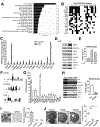EGFR Activates a TAZ-Driven Oncogenic Program in Glioblastoma
- PMID: 33910930
- PMCID: PMC8277712
- DOI: 10.1158/0008-5472.CAN-20-2773
EGFR Activates a TAZ-Driven Oncogenic Program in Glioblastoma
Abstract
Hyperactivated EGFR signaling is a driver of various human cancers, including glioblastoma (GBM). Effective EGFR-targeted therapies rely on knowledge of key signaling hubs that transfer and amplify EGFR signaling. Here we focus on the transcription factor TAZ, a potential signaling hub in the EGFR signaling network. TAZ expression was positively associated with EGFR expression in clinical GBM specimens. In patient-derived GBM neurospheres, EGF induced TAZ through EGFR-ERK and EGFR-STAT3 signaling, and the constitutively active EGFRvIII mutation caused EGF-independent hyperactivation of TAZ. Genome-wide analysis showed that the EGFR-TAZ axis activates multiple oncogenic signaling mechanisms, including an EGFR-TAZ-RTK positive feedback loop, as well as upregulating HIF1α and other oncogenic genes. TAZ hyperactivation in GBM stem-like cells induced exogenous mitogen-independent growth and promoted GBM invasion, radioresistance, and tumorigenicity. Screening a panel of brain-penetrating EGFR inhibitors identified osimertinib as the most potent inhibitor of the EGFR-TAZ signaling axis. Systemic osimertinib treatment inhibited the EGFR-TAZ axis and in vivo growth of GBM stem-like cell xenografts. Overall these results show that the therapeutic efficacy of osimertinib relies on effective TAZ inhibition, thus identifying TAZ as a potential biomarker of osimertinib sensitivity. SIGNIFICANCE: This study establishes a genome-wide map of EGFR-TAZ signaling in glioblastoma and finds osimertinib effectively inhibits this signaling, justifying its future clinical evaluation to treat glioblastoma and other cancers with EGFR/TAZ hyperactivation. GRAPHICAL ABSTRACT: http://cancerres.aacrjournals.org/content/canres/81/13/3580/F1.large.jpg.
©2021 American Association for Cancer Research.
Conflict of interest statement
Conflict of interest statement
The authors declare no potential conflicts of interest.
Figures







Similar articles
-
YAP/TAZ Transcriptional Coactivators Create Therapeutic Vulnerability to Verteporfin in EGFR-mutant Glioblastoma.Clin Cancer Res. 2021 Mar 1;27(5):1553-1569. doi: 10.1158/1078-0432.CCR-20-0018. Epub 2020 Nov 10. Clin Cancer Res. 2021. PMID: 33172899 Free PMC article.
-
Circular RNA-encoded oncogenic E-cadherin variant promotes glioblastoma tumorigenicity through activation of EGFR-STAT3 signalling.Nat Cell Biol. 2021 Mar;23(3):278-291. doi: 10.1038/s41556-021-00639-4. Epub 2021 Mar 4. Nat Cell Biol. 2021. PMID: 33664496
-
A Preclinical Investigation of GBM-N019 as a Potential Inhibitor of Glioblastoma via Exosomal mTOR/CDK6/STAT3 Signaling.Cells. 2021 Sep 11;10(9):2391. doi: 10.3390/cells10092391. Cells. 2021. PMID: 34572040 Free PMC article.
-
Clinical activity of the EGFR tyrosine kinase inhibitor osimertinib in EGFR-mutant glioblastoma.CNS Oncol. 2019 Nov 1;8(3):CNS43. doi: 10.2217/cns-2019-0014. Epub 2019 Nov 15. CNS Oncol. 2019. PMID: 31769726 Free PMC article. Review.
-
A Rational Approach to Target the Epidermal Growth Factor Receptor in Glioblastoma.Curr Cancer Drug Targets. 2017;17(3):290-296. doi: 10.2174/1568009616666161227091522. Curr Cancer Drug Targets. 2017. PMID: 28029074 Free PMC article. Review.
Cited by
-
Glioma targeted therapy: insight into future of molecular approaches.Mol Cancer. 2022 Feb 8;21(1):39. doi: 10.1186/s12943-022-01513-z. Mol Cancer. 2022. PMID: 35135556 Free PMC article. Review.
-
Repurposing the drug verteporfin as anti-neoplastic therapy for glioblastoma.Neuro Oncol. 2022 May 4;24(5):708-710. doi: 10.1093/neuonc/noac019. Neuro Oncol. 2022. PMID: 35100422 Free PMC article. No abstract available.
-
Brain Tumors: Development, Drug Resistance, and Sensitization - An Epigenetic Approach.Epigenetics. 2023 Dec;18(1):2237761. doi: 10.1080/15592294.2023.2237761. Epigenetics. 2023. PMID: 37499114 Free PMC article. Review.
-
The Prognostic Significance of Epidermal Growth Factor Receptor Amplification and Epidermal Growth Factor Receptor Variant III Mutation in Glioblastoma: A Systematic Review and Meta-Analysis with Implications for Targeted Therapy.Int J Mol Sci. 2025 Apr 9;26(8):3539. doi: 10.3390/ijms26083539. Int J Mol Sci. 2025. PMID: 40331985 Free PMC article.
-
EGFR signaling promotes nuclear translocation of plasma membrane protein TSPAN8 to enhance tumor progression via STAT3-mediated transcription.Cell Res. 2022 Apr;32(4):359-374. doi: 10.1038/s41422-022-00628-8. Epub 2022 Feb 23. Cell Res. 2022. PMID: 35197608 Free PMC article.
References
Publication types
MeSH terms
Substances
Grants and funding
LinkOut - more resources
Full Text Sources
Other Literature Sources
Research Materials
Miscellaneous

